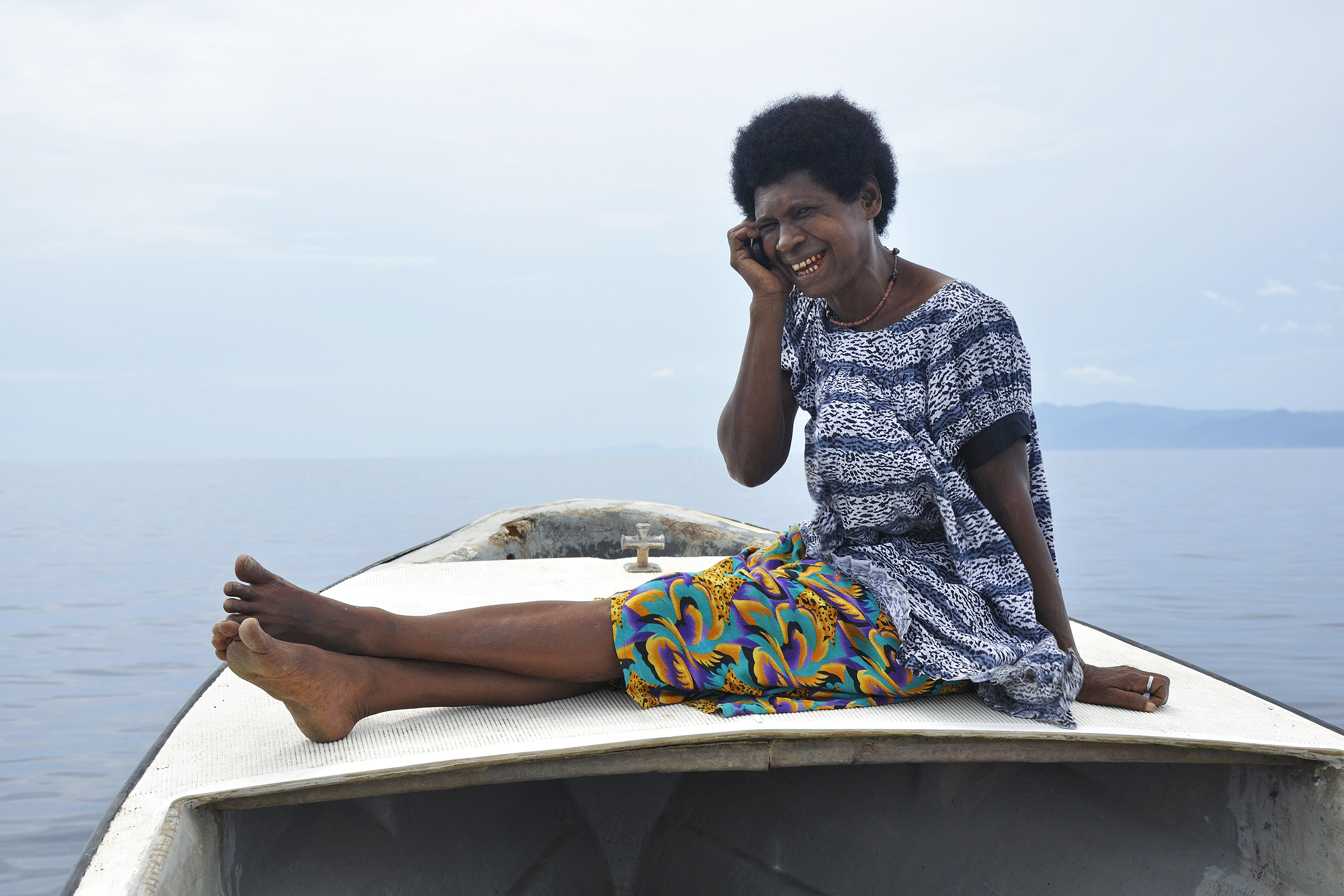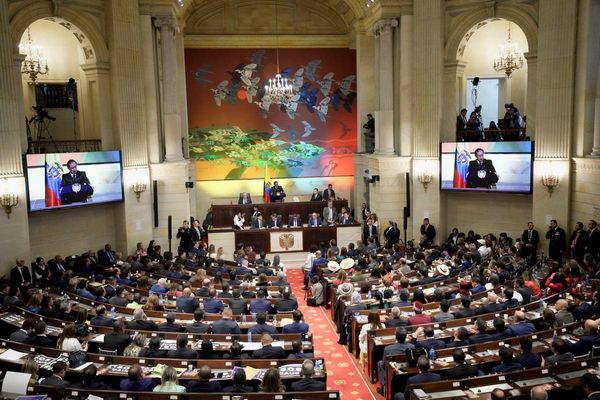
With its 830 distinct languages, Papua New Guinea is the most linguistically diverse nation in the world. Perhaps that’s because, as some argue, small groups deliberately maintained their identities with distinct languages. Or perhaps it reflects the country’s topographical features — the steep mountain ranges, wide rivers and dense forests that divide small, scattered communities.
Whatever the reasons, these barriers create obvious communication problems. Infrastructure to facilitate physical movement — roads, wharves, airports — is costly to build and maintain. Tropical cyclones, landslides and earthquakes disrupt mobility and communication. Only those who live in the country’s urban communities have enjoyed full “infrastructural citizenship.”
Now, though, telecommunication technology, especially mobile phones, is enabling a connectivity that was impossible twenty years ago. It is this revolution in communications that is the subject of anthropologist Robert Foster’s “partial history,” Uneven Connections, which focuses on the fortunes of a key mobile provider, Digicel.
As Foster observes, infrastructure projects are highly political, especially in PNG, where failed projects “often materialise the state’s broken promises to its citizens.” Funding shortfalls, engineering complexities and maintenance challenges all affect the users’ capacity to engage with the new “infrastructural assemblage.”
Uneven Connections opens with an exploration of three crucial elements a new mobile provider must assemble — licences, towers and gateways — which can prove easier said than done. Although PNG committed to liberalising its telecommunications systems in 2002, concerted opposition came from the state-owned enterprises that owned all three. Telikom maintained its monopoly until 2007, when its subsidiary company Pacific Mobile Communications and the foreign-owned Digicel PNG gained licences to operate.
Digicel, a private company based in Jamaica but owned by billionaire Irishman Denis O’Brien, had begun operations in the Caribbean and rapidly extended services to Central America. Its success in that region and later in the Pacific reflected its strategy of operating in small, economically undeveloped countries where incomes were low and state services poor.
In PNG, Digicel’s combination of cheap phones and prepaid calls was immediately successful. Foster describes how the company dodged attempts by state enterprises to block or restrict its operations. With Telikom retaining a monopoly on the undersea cable “gateways,” for example, Digicel used satellites for voice and data traffic. Its capacity for outwitting competitors and establishing its mobile network quickly and efficiently was undoubtedly a major reason for its success.
Papua New Guineans have ways of thwarting projects when they think they aren’t receiving adequate benefits. Digicel’s decision to build transmission towers in rural areas meant it had to negotiate access to suitable sites with customary landowners. Compensation or rent payments were almost invariably contentious and frequently involved claims and counterclaims from different groups of landowners.
When they thought that they were unfairly treated, disgruntled landowners vandalised or destroyed towers. But here too, Digicel was able to outmanoeuvre opposition — sometimes by changing the location of the tower and at least once by simply shutting down transmission in the area.
Mobile phones obviously met a need, and by 2008, just a year after its launch, Digicel dominated the market. O’Brien’s aggressive marketing tactics had been well-honed by the time he arrived in PNG. The company’s red-and-white logo was everywhere — on flags and pennants hoisted from poles, on buses and shopfronts, and every day for two months after the launch in full-page spreads in the national newspapers with promises of cheaper rates, cheaper handsets and services to hitherto-neglected rural communities. A decade later the company had 92 per cent market share.
Digicel marketed its handsets and plan vigorously. In one of its most successful campaigns it offered two-for-one handsets, subsiding the extra handset to guarantee a doubling of usage. As with all loyalty programs it involved the illusion that customers have a special relationship with a company that “rewards” them with “gifts.” This tactic has particular resonance in Papua New Guinea, where local marketing rarely involves overt price competition and the emphasis on the friendly relationship between buyer and seller. The idea of the company’s generosity also underpinned Digicel’s sponsorships of popular sporting teams and cultural events.
In various ways, Digicel’s marketing campaigns incorporated images of local people as modern, global citizens. Through its advertising, the company created an idealised national identity: citizens united by a network. While it has sometimes used pictures of men or women in traditional dress, more often the appeal has been to young people and their desire to be fashionable consumers.
But the relationship is more complex than that. Foster’s analysis of the moral economy of mobile phones reveals how customers engage with the technology “in ways neither anticipated nor imagined by providers.”
Digicel’s customers found creative ways of avoiding paying for messages, for example, by using the free texts permitted to request credit. “Flashing,” “beeping” (dialling and quickly disconnecting so that the recipient can see the number) and other workarounds also enabled callers to contact others while avoiding payment. When Digicel introduced a free “call me” text message — designed to make sure a paid call was made — customers exploited the facility by using numbers, disguised as a credit requests, as coded responses: thus, a request to meet could be confirmed by responding K12 7, indicating noon and a predetermined place.
As elsewhere in the world, locals enthusiastically embraced texting and its accompanying abbreviated idioms as novel and cheaper ways of conversing. Digicel encouraged messaging by offering bundles’ with bonus texts built in. As the habit of communicating by text messages took hold, the price per text was reduced, establishing patterns of regular usage.
As Foster observes, the prepaid system strikes a commercially astute balance. Having ensured that all calls are paid for, it helps to instil “time thrift” by forcing consumers to discipline their communications in order to get value for money, but it also imposes a time limit whereby the customer risks wasting money if the prepayment is not entirely used. In short, Digicel’s ploys all served to encourage customers to maximise their usage without risking non-payment for services. When credit was extended, it was only to customers who had demonstrated consistent paid usage, and the credit was limited to a single day.
While Digicel exerted control over the formal economics of supply and demand, an informal economy also emerged. Street vendors bought and sold credit in the form of flex cards or direct credit transfer from their handsets, adding a small markup to the face value. Some offered repair and recharging services. One interviewee provided repair services to rural villagers in return for bananas or sweet potatoes. Phone credits became a type of remittance from urban workers to rural family members who could either use them or resell them to third parties.
The vitality of this informal sector reflects the ingenuity of Papua New Guineans, but the fact that people make such small gains from each transaction also indicates the impoverished base from which they work. Vendors perceive themselves as part of Digicel’s corporate community, extending their services and helping customers, and therefore expect recognition. Digicel presumably sees the relationship as a form of appropriation and would almost certainly reject local understandings of reciprocity that would entail obligation to the street vendors.
Mobile telephones can be seen positively, as expansive, connecting people across PNG and facilitating communication. But they are also domestically disruptive, enabling secret liaisons and illicit affairs. By storing the numbers and texts that are evidence of infidelity or extra-marital relationships, the phone itself can be the cause of conflict. Mistrust of partners and surveillance of their communications have become common. Phone friendships, often formed simply by making random calls and chatting, are a source of fantasy and titillation.
But the issue of caller identification is contentious, at both the personal and the state level. Fears that unknown, untraceable callers jeopardise national security and personal safety prompted legislation for SIM card registration as early as 2012. Telecommunication companies had to bear the full costs of the registration process as well as the losses when rural residents, who couldn’t readily access places to do so, failed to comply. Companies were willing to carry the cost in the hope that in future e-commerce would become the norm in banking, shopping and the payment of bills. This still seems a long way off in PNG.
Promises of the benefits of mobile banking have been circulating in the Pacific region for decades. Digicel quickly became the platform for all mobile money transactions, with customers using their digital wallets to withdraw funds. It also benefited disproportionately by charging banks a fee whenever customers checked their balances and by facilitating money transfers for talk time. One bank that monitored mobile banking usage found that more than two-thirds of mobile transfers were payments to Digicel.
More problematic, says Foster, is the introduction of cybercrime laws covering a “very large range of offences including cyberbullying, hacking, sending indecent materials, spreading false information, spamming, electronic fraud, defamation and sedition.” Concerns over the legislation’s possible suppression of free speech, especially criticism of politicians, appear to have been unfounded: as elsewhere, PNG politicians are frequently subjected to online ridicule and criticism but very few lawsuits have ensued. Threats to ban or censor Facebook and interventions that prevent online hate speech and disinformation remain rhetorical.
Foster’s main achievement in this book is to demonstrate how neoliberal policies touted by the World Trade Organization affect nations in which the majority of the population is poor and the state is weak. Companies such as Digicel (and international mining companies) establish foundations or special projects that benefit communities by building classrooms or health centres or supporting local economic development. Such activities count as “corporate social responsibility” and feature prominently in the reports, public relations literature and advertising that companies disseminate.
Successive governments’ failure to provide basic services (including effective communication systems) means that gifts like these are accepted with alacrity. Digicel’s slogans emphasise equity of access, with school classrooms and educational initiatives consolidating notions of shared “infrastructural citizenship.” But such “philanthrocapitalism” further weakens governments and contributes to the pervasive cynicism about the state’s capacity to provide infrastructure and services. Digicel’s foundation, nominally separated from the company, is probably best seen as its advertising arm.
As Foster points out, Denis O’Brien’s vision of “post-political governance” aligns perfectly with crude depictions of Adam Smith’s “invisible hand,” whereby unfettered capitalism will allegedly benefit citizen and companies alike. Unfortunately, the benefits are proving to be extremely uneven. While Digicel did initially “connect the unconnected,” the divide between rural and urban citizens has opened up again and infrastructural inequalities persist.
While smartphones altered the dynamics of communication and access to the internet, wi-fi connectivity and even the availability of charging facilities are often impossible in rural locations. Denis O’Brien made millions from his companies in the Caribbean, Central America and the Pacific. Ironically, given his neoliberal views on the role of the state, he also benefited enormously from government intervention. In 2022, at the behest of the Australian government, Telstra bought the Pacific operations of Digicel in order to pre-empt Chinese investment. Telstra contributed $270 million and Australian taxpayers $1.33 billion.
Foster’s partial history concludes with some ruminations on the consequences of this transaction. In some ways it continues a neo-colonial relationship with Australia; in others it simply transfers ownership and management from one private company to another, with the PNG government continuing to have little control at all. •
Uneven Connections: A Partial History of the Mobile Phone in Papua New Guinea
By Robert J. Foster | ANU Press | $59.99 | Free to download | 221 pages
The post Upwardly mobile appeared first on Inside Story.







